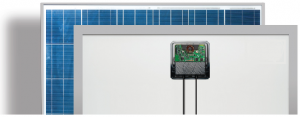While no one argues that investing in PV modules isn’t a smart move today, it won’t be long before we start asking if our modules are just as smart – with power optimisation, that is!
The recent debut of Trina Solar’s ‘Trinasmart’ modules in the US marks the entry of the world’s second largest module manufacturer into the American smart module market. The announcement comes at the heels of TÜV recently announcing a new certification process for smart modules. The buzz around smart modules has just gotten louder.
To understand what makes a module smart, consider first a standard module, which simply dumps its current/energy into the string to which it is connected. While this is a simple solution that works well in ideal conditions, it can lead to significant array losses in power when one or more modules within a string are shaded. It also limits the number of modules that can be safely connected in a single string.
By adding a power optimiser to a DC module, the current and voltage output can be controlled such that the string current is not compromised by a shaded module. Also, by limiting the voltage such that the module is allowed to output up to the maximum power point but less than the open-circuit voltage (where very little power is generated), more modules can be safely connected to the same inverter. By performing such power optimisation on all modules in a system, the net energy output can be improved significantly, particularly for medium- and large-scale PV systems.
Tigo ‘Energy Maximizer’ integrated into a solar panel
According to Tigo Energy, a manufacturer of module-level power optimisers, the energy output of a string can be increased by as much as 20% by using such module-level power optimisers. However, more realistic figures of 3% were recently reported in the US, where a 113 kW system was commissioned by Cobalt Power using Trina Solar’s ‘Trinasmart’ panels embedded with Tigo’s power optimiser technology.
Incorporating electronics at the module level can also enable module-level monitoring and remote disconnection of individual modules, which can make modules safer and enable cost-effective maintenance of individual modules as needed. All such electronics, including the power optimiser, can be incorporated into the junction box of the module – making it easy for module manufacturers to adopt the technology.
The concept of embedded optimisers is not new, with the first such smart modules being manufactured in 2010 by GESOLAR using National Semiconductor’s ‘SolarMagic’ technology. However, SolarEdge’s technology has proven to be more popular, currently accounting for 70% of the global market in terms of module shipments. SolarEdge has also begun teaming up with panel manufacturers, with industry heavyweights such as ReneSola and LDK Solar among others adopting the technology for module integration. Meanwhile, Tigo Energy is the leader in terms of ‘smart module’ shipments world-wide, having already tied up with Trina Solar, Luxor, Upsolar plus a number of others–and plans to announce partnerships with more tier-1 manufacturers soon.
However, the advantages of module-level power optimisation are not limited to these newer smart modules. For system owners looking to re-design their systems or simply to maximise power on their existing modules, the market offers power optimiser electronics which can be simply tacked on to the junction box of existing standard modules – such as those offered by SolarEdge.
The increasing importance and availability of such embedded power optimisers has raised questions about their reliability and put pressure on standards and certification authorities, whose current testing standards only apply for standard modules.
In a significant development, the PV module certification body, TÜV, announced a new certification process to assess the reliability of smart modules. The new certification test combines existing standard reliability tests to produce a series of new test procedures to rigorously test both AC and DC smart modules. More than three different module products have already been tested and graded by the certification body.
In response, module manufacturers and, more importantly, PV plant operators have recognised the new certification process. If their endorsement is any indicator, the market growth in smart modules definitely seems positive.
© 2014 Solar Choice Pty Ltd
- Future of Utilities – Part 1: The death of base-load generators - 11 September, 2014
- Sharp enters energy storage market with SmartStorage - 18 August, 2014
- Phinergy extends electric car range with metal-air battery technology - 13 August, 2014

I am interested in a stand alone system (5 kw) using micro inverters.
Enphase and APS micro inverters need 240 vac to function.
So my solution and question: 5 kw of panels with micro inverters feeding into the an inverter 240 vac to 24 vdc battery bank, from the battery bank to another inverter 24 vdc to 240 vac to connect to house and the solar panels,,,, thus the panels will get 240 vac,,,
Will this work ??? of course the battery will be charged initially from other source.
Kind regards
john
Hi John,
It would be best for you to speak with an installer or company that is active in the batteries/energy storage arena. We have a list of such companies in this article if you want to investigate this further.